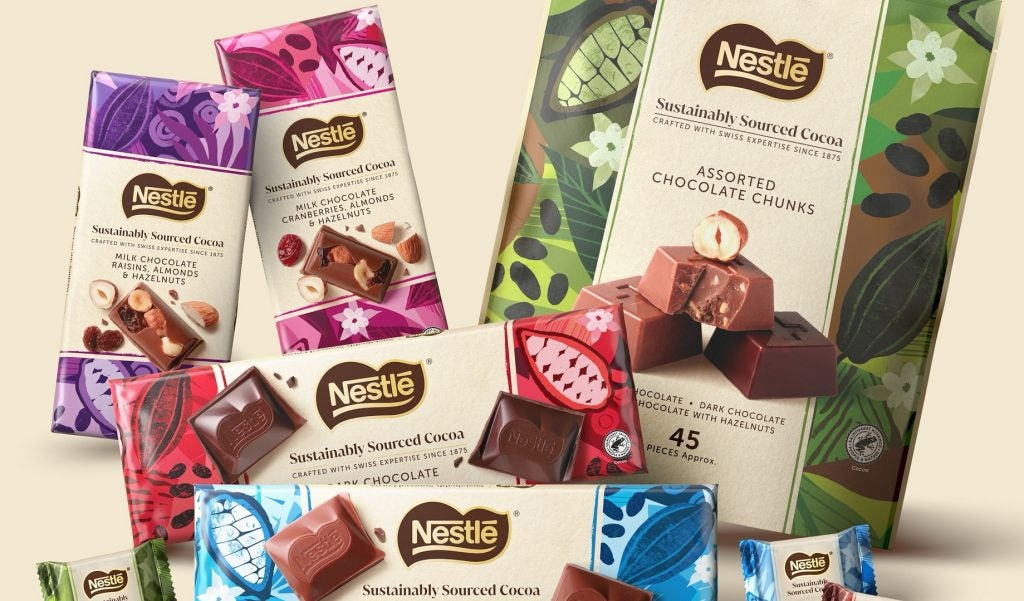Nestlé is aiming to further strengthen its sustainability credentials through the launch of its travel retail-exclusive Nestlé Sustainably Sourced chocolate range.
The Switzerland-based food giant, owner of chocolate brands including KitKat and Smarties, says the new product reflects its “long-standing heritage in chocolate making”, as well as “the company’s commitment to responsible sourcing”.
The company sources cocoa through its Nestlé Cocoa Plan, a programme set up 15 years ago and through which it works with the Rainforest Alliance.
Nestlé says it is “committed” to sourcing all its cocoa through the Nestlé Cocoa Plan by 2025. In 2023, the company says it had procured 85.5% of the commodity through the programme.
The launch of Sustainably Sourced follows on from other sustainability initiatives in the confectionery area from the company. In January, Nestlé rolled out a range of KitKat chocolate made using cocoa grown by farmers working under its income accelerator initiative. The product, called KitKat Breaks for Good, is being sold in 27 European countries.
Like that initiative, the Sustainably Sourced travel-retail exclusive is linked to claims ranging from sustainably sourced cocoa to more trees planted.
Nestlé suggests consumers are increasingly seeking products made with responsibly sourced ingredients, such as cocoa, supported by clear claims and measurable progress on the critical issues faced by producers. The company says the sustainability agenda is gaining momentum in the travel-retail sector, quoting research showing 71% of travellers state it influences their purchasing decisions.
Nestlé Sustainably Sourced chocolate is crafted using cocoa certified by the Rainforest Alliance and sourced through the Nestlé Cocoa Plan.
But why has it been launched solely in travel retail and what are Nestlé's plans for the product?
Aura Sanchez, a former marketing manager at PepsiCo and more recently Nestlé’s KitKat global brand manager, is now head of marketing at Nestlé Travel Retail and was central to this launch. Just Food caught up with her to ask about the development of the product and Nestlé’s plans for the range.
Andy Coyne (AC): Why is Nestlé targeting travel retail with the new range?
Aura Sanchez (AS): There is a need to compensate because of airports and planes etc [causing air pollution] so when we reached out to customers and asked about their sustainability commitments they thought this really added value.
On the other side, we tested with consumers. Younger consumers are the ones who travel the most and even more so since Covid. They are passionate about their travelling experience. We tested that and were pleased to see that sustainability was at the core [of their thinking]. We worked with a company with a database of travellers, from all nationalities. The concept was to showcase positive results.
AC: Aside from compensating for air pollution, are airports a good place to launch such products?
AS: The third piece [of the launch plan] was that chocolate retail [in airports] is the window of the world. You can find travellers, shareholders, stakeholders exposed to this type of message.
AC: The campaign visuals will encourage customers to learn more about the Nestlé Cocoa Plan and the work with the Rainforest Alliance but what about taste and format?
AS: The product has crowd-pleasing flavours for the younger generation and different textures. Also gifting and sharing are important [for this launch] with big bars that you can’t find domestically. We decided to go with bigger tablets to make them more giftable and they can be personalised. Travellers will be able to personalise their 170g and 280g bars by adding their own messages to the product sleeves.
AC: What is the timing of this launch?
AS: We started receiving orders [from airports] in March and the products have been in airports since April. It is available in all markets. the product needs to be compliant everywhere in terms of chocolate mass and ingredients etc.
AC: Am I right in thinking this is a premium-priced product?
AS: There are different segmentations, including formal gifting with premium solutions. It is premium but at a lower price point than major competitors.

AC: In line with Nestlé confectionery brands such as Smarties that have moved to paper packaging, Nestlé Sustainably Sourced will also be available in a recyclable paper pouch. But, more widely, how does it fit into the company’s sustainability agenda?
AS: Through creative branding, we can provide transparency on the origin of the cocoa used in our chocolate. It enables us to raise awareness about our long-standing commitments to supporting cocoa-farming families and the long-term sustainability of cocoa production.
AC: What are those commitments?
AS: As part of the Nestlé Cocoa Plan, over 1.2 million forest and fruit trees have so far been distributed to cocoa farmers. This product is produced in Spain and Switzerland and has Fairtrade certification from the Rainforest Alliance.
AC: Doing good by the planet is very laudable, of course, but confectionery is a highly competitive sector. What do you see as the competitive advantage of a product like Sustainably Sourced?
AS: One of the main competitive advantages is that if you look at what our competitors are doing it is sometimes hard to find certification like Rainforest Alliance. There is also the dynamic of promises for 2030 etc but we can say we are doing this already.
AC: But why make the products airport-specific? Wouldn’t making the new range more widely available be helpful in getting the sustainability message across?
AS: In the short term it is [airport-specific] but we cannot hide that the market is knocking the door down and asking when they can have it as well. We will have to consider that but we have no plans for that right now. But we do have plans for the future to keep expanding the range and for more gifting solutions for a ‘gift with purpose’.









